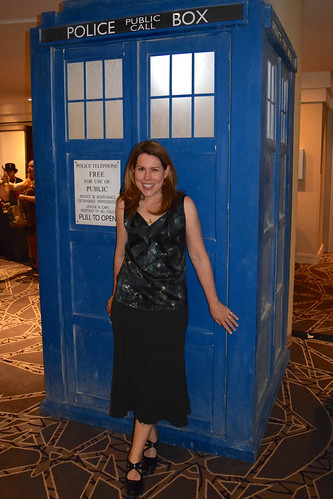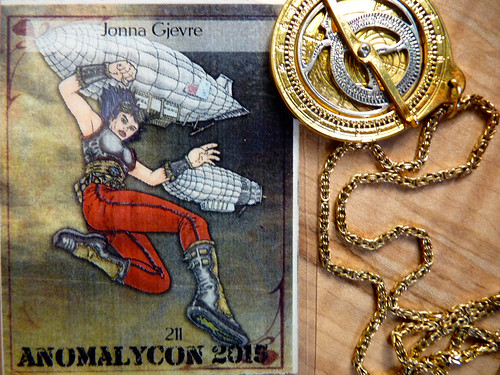 Last weekend, juggling a whole slew of commitments, I careened through space and time, miraculously arriving without a moment to spare at AnomalyCon, Denver’s premiere steampunk and alternate history convention.
Last weekend, juggling a whole slew of commitments, I careened through space and time, miraculously arriving without a moment to spare at AnomalyCon, Denver’s premiere steampunk and alternate history convention.
The other time travelers in attendance sported top hats, bustles, corsets, and aviator goggles, and they all looked fantastic. I had serious costume envy. After paying a quick visit to my old friend the TARDIS, I collected my badge, which is possibly the most exquisite convention badge I’ve ever seen, then headed downstairs for my panel.
 I moderated a panel on Non-Western Alternate History, which refers to divergent historical narratives placed outside the European tradition. Most alternate histories written in English are set in Europe or the States and consequently engage with events that most Western readers know quite well, like the Civil War or World War II. For example, in Michael Chabon’s novel The Yiddish Policemen’s Union, readers are able to contrast Chabon’s description of a Jewish State established in Alaska with their knowledge of what really happened in WWII.
I moderated a panel on Non-Western Alternate History, which refers to divergent historical narratives placed outside the European tradition. Most alternate histories written in English are set in Europe or the States and consequently engage with events that most Western readers know quite well, like the Civil War or World War II. For example, in Michael Chabon’s novel The Yiddish Policemen’s Union, readers are able to contrast Chabon’s description of a Jewish State established in Alaska with their knowledge of what really happened in WWII.
In a sense, a writer who chooses to present an alternate version of a non-Western history has an especially difficult road, since readers may not know enough about feudal Japan, for example, to recognize where the storyline has diverged from history, or (more importantly) why that divergence is important.
My panelists were all authors of alternate historical narratives, and they had fascinating insights to share. Author Stant Litore discussed his research for writing zombie novels set in the ancient world. T.L. Morganfield talked about language traditions and the role of Spanish conquest in her Aztec-themed novels. And Travis Heermann told us about living in Japan for three years to develop his Spirit of the Ronin narratives. I was particularly struck by Morganfield’s approach to helping her audience bridge the gap between the received historical tradition and her divergent narrative: to remind the reader of the real historical narrative, she treated it as a hypothetical “what if” in her protagonist’s dreams.
The audience at our panel was creative and engaged, asking thoughtful questions about research, cultural appropriation, and language choices. Overall, it was an excellent panel, and I was grateful to be a part of it. Definitely, I’m looking forward to my next AnomalyCon. But next year, I promise I won’t double-book my weekend, and I’ll be sure to enjoy the full convention experience.
Allow me to share one more image from the convention. Below is the artwork used on the AnomalyCon T-shirts. It’s luscious, very steampunky, and a simple visual reminder that steampunk and alternate histories can extend beyond the street lamps of London, encompassing the broader world.
